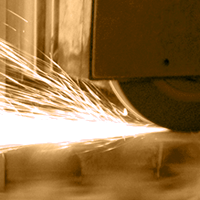Hard Turning: The Ideal Machine for the Job
 When considering hard turning, the question is not “Can it be done?” because many machine tools can hard turn. Instead the question is, “How well can it be done?” Success in hard turning is largely a measure of the machine construction and design along with the workholding and tool holding. The level of rigidity and damping in a hard turning application cannot be minimized. That’s where Hardinge has a competitive advantage.
When considering hard turning, the question is not “Can it be done?” because many machine tools can hard turn. Instead the question is, “How well can it be done?” Success in hard turning is largely a measure of the machine construction and design along with the workholding and tool holding. The level of rigidity and damping in a hard turning application cannot be minimized. That’s where Hardinge has a competitive advantage.
Success in Hard Turning is defined by a number of factors:
- Machine rigidity
- Workholding Rigidity
- Good vibration damping characteristics
- Rigid tool location
- Component part rigidity
Rigid cutting tools and advanced insert materials Hardinge lathes meet these requirements with the following key features.
- Machine Rigidity: Heavy-duty linear guideways on Hardinge QUEST lathes are typically 40-60% heavier-duty units than those fitted to most competitive machine tools of the same size. The low-stress drive systems on QUEST machines have larger axis motors and shorter pitch ballscrews than most competitive machines, making for high dynamic stiffness--critical for successful hard turning.
- The patented Hardinge spindle design on Hardinge QUEST and ELITE series lathes ensures that the workpiece is seated as close as possible to the spindle bearings for maximum rigidity and accuracy. This greatly improves the Hard turning process compared to competitive workholding solutions.
- In addition, Hardinge is the largest manufacturer of lathe spindle tooling systems in the world. This ensures that the workholding systems made for our machines are designed specifically for our machines.
QUEST lathes are built on a rigid cast iron base with HARCRETE Polymer Composite reinforcement. Vibration damping is critical to the successful application of hard turning. HARCRETE is located in key positions of the base to assure maximum rigidity. This unique design can help you save 30% or more on cutting tool expenses, and reduce vibration at the spindle by 60%.
All external tools on QUEST machines equipped with Hardinge turrets mount directly into the tool slots provided in the turret body. The close proximity of the cutting tool to the coupling reduces the risk of vibration, thus improving the Hard Turning process.
- QUEST lathes feature digital glass scales incorporated for both the X and Z axes. The spindle motor and collet closer assemblies are dynamically balanced. And X and Z axis error compensation is performed to fine tune positioning and compensate offset at the tool tip.
In short, Hardinge machines offer the ideal machining process from the standpoint of part cost, capability, and accuracy.
 |